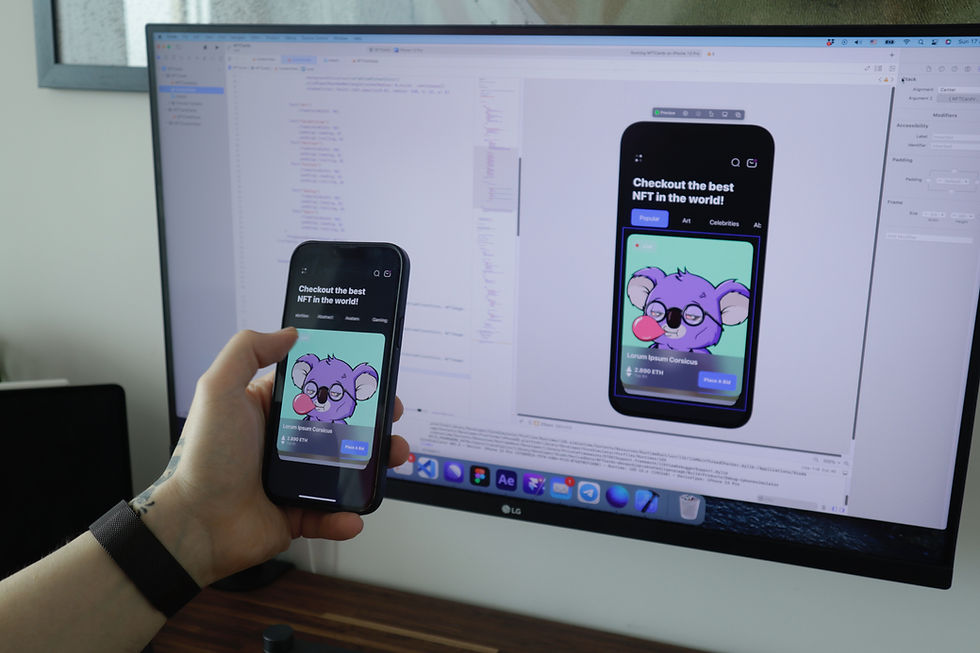A Comprehensive Guide on How to Test Flutter Mobile Apps
- May 24, 2023
- 4 min read

In the fast-paced world of mobile app development, ensuring the quality and reliability of your application is crucial. Flutter, a popular cross-platform framework developed by Google, has gained significant traction among developers for its ability to create stunning mobile apps for both Android and iOS platforms. Testing plays a vital role in delivering a successful Flutter app, ensuring its functionality, performance, and user experience.
In this blog post, we will explore the different aspects of testing Flutter mobile apps and provide a comprehensive guide to help you achieve a robust and reliable application.
Understanding Flutter Testing Fundamentals
Before diving into the testing process, it's essential to familiarize yourself with the basic testing concepts in Flutter.
Flutter provides several testing frameworks and tools, including unit testing, widget testing, and integration testing. Understanding these concepts will allow you to choose the appropriate testing approach based on your application's requirements.
1. Writing Unit Tests
Unit tests are the foundation of any test suite and focus on testing individual units of code. In Flutter, you can use the built-in test package, which provides utilities for writing and executing unit tests. Unit tests help validate the behavior of functions, classes, and methods in isolation, ensuring that they produce the expected output for a given input.
Let's take a look at an example of a unit test:
import 'package:test/test.dart';
int sum(int a, int b) {
return a + b;
}
void main() {
test('Sum function adds two numbers correctly', () {
expect(sum(2, 3), equals(5));
expect(sum(0, 0), equals(0));
expect(sum(-1, 1), equals(0));
});
}
In this example, we define a sum function that adds two numbers. We then write a unit test using the test function from the test package. The expect function is used to assert that the actual result of the sum function matches the expected result.
2. Widget Testing
Widget testing in Flutter involves testing the UI components of your application. It allows you to verify if the widgets render correctly and behave as expected. The Flutter framework provides the flutter_test package, which offers a rich set of APIs for widget testing. With widget testing, you can simulate user interactions, verify widget states, and test widget rendering across different screen sizes and orientations.
Here's an example of a widget test:
import 'package:flutter_test/flutter_test.dart';
import 'package:flutter/material.dart';
void main() {
testWidgets('Button changes text when pressed', (WidgetTester tester) async {
await tester.pumpWidget(MaterialApp(
home: Scaffold(
body: ElevatedButton(
onPressed: () {},
child: Text('Button'),
),
),
));
expect(find.text('Button'), findsOneWidget);
await tester.tap(find.byType(ElevatedButton));
await tester.pump();
expect(find.text('Button Pressed'), findsOneWidget);
});
}
In this example, we create a widget test using the testWidgets function from the flutter_test package. We use the pumpWidget function to build and display the widget hierarchy. Then, we use the find function to locate the widget we want to interact with, and the tap function to simulate a tap on the widget. Finally, we assert that the widget's text changes to 'Button Pressed' after the tap.
3. Integration Testing
Integration testing focuses on testing the interaction between multiple components of your application, such as different screens, databases, APIs, and external dependencies. Flutter provides a powerful testing framework called Flutter Driver, which allows you to write integration tests that interact with your app as if a real user were using it. Integration tests help identify issues related to navigation, data flow, and interactions between different parts of your app.
Here's an example of an integration test:
import 'package:flutter_driver/flutter_driver.dart';
import 'package:test/test.dart';
void main() {
FlutterDriver driver;
setUpAll(() async {
driver = await FlutterDriver.connect();
});
tearDownAll(() async {
if (driver != null) {
driver.close();
}
});
test('Login and navigate to home screen', () async {
await driver.tap(find.byValueKey('username_field'));
await driver.enterText('john_doe');
await driver.tap(find.byValueKey('password_field'));
await driver.enterText('password123');
await driver.tap(find.byValueKey('login_button'));
await driver.waitFor(find.byValueKey('home_screen'));
});
}
In this example, we use the flutter_driver package to write an integration test. We set up a connection to the Flutter driver using the FlutterDriver.connect method. Then, we define a test that simulates a login flow by interacting with various widgets using the tap and enterText methods. Finally, we assert that the home screen is successfully displayed.
Test-Driven Development (TDD)
Test-Driven Development is a software development approach that emphasizes writing tests before writing the actual code. With TDD, you define the desired behavior of your app through tests and then write code to fulfill those test requirements. Flutter's testing tools and frameworks integrate seamlessly with TDD practices, making it easier to build reliable and maintainable applications. By writing tests first, you ensure that your code is thoroughly tested and behaves as expected.
Continuous Integration and Delivery (CI/CD)
Incorporating a robust CI/CD pipeline for your Flutter app is crucial to automate the testing process and ensure consistent quality across different stages of development. Popular CI/CD platforms like Jenkins, CircleCI, and GitLab CI/CD can be integrated with Flutter projects to run tests automatically on every code commit or pull request.
Additionally, you can leverage tools like Firebase Test Lab to test your app on various physical and virtual devices, ensuring compatibility and performance across different configurations.
Using Tools for Testing
Using tools like Firebase, Instabug, BugSnag and Finotes to detect performance issues and other bugs will help you in detecting bugs which may otherwise go undetected in manual testing. They provide detailed bug reports with data that will help you to reproduce the bug and identify the root cause.
Conclusion
Testing is an integral part of the Flutter app development process, ensuring that your app functions as intended and delivers an excellent user experience. By following the practices outlined in this comprehensive guide and using the provided code samples, you can build a solid testing strategy for your Flutter mobile apps.
Remember to invest time in writing unit tests, widget tests, and integration tests, and consider adopting test-driven development practices. Furthermore, integrating your testing efforts with a reliable CI/CD pipeline will help you maintain a high level of quality and efficiency throughout the development lifecycle.
Last but not the least, use tools like Firebase, Instabug, BugSnag and Finotes to detect performance issues and bugs.
Happy testing!



Comments